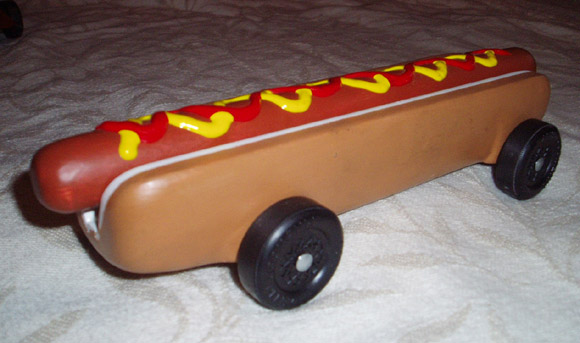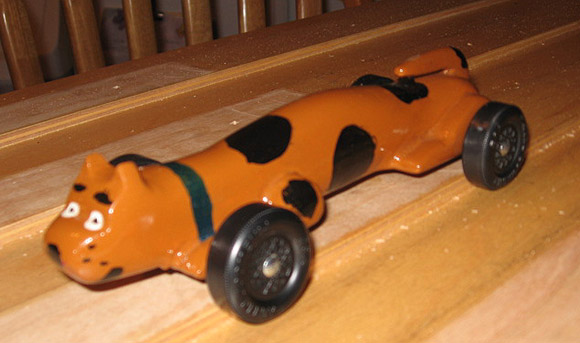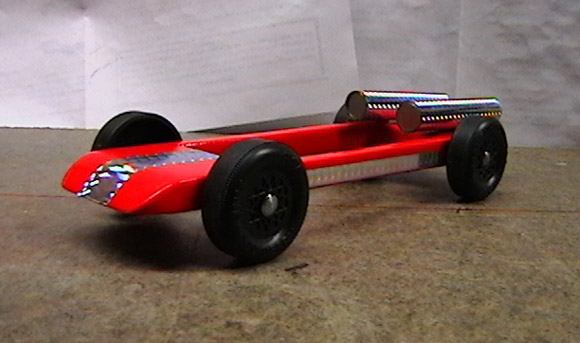– Feature Article – Points or Times: Which Method Should I Use?
– Pinewood Derby Car Showcase
– Memory – Never Too Late to Start
– Q&A
Points or Times: Which Method Should I Use?
Life used to be simple. Only a few TV channels to choose from, no Starbucks to give us multiple coffee options, and pinewood derby winners were decided by elimination. But since humans thrive on innovation, we now have lots of channels and coffee choices, and we have other options for running pinewood races.
I for one am pleased that other options exist for deciding pinewood derby winners. For years we used a double-elimination method. I tried very hard to make the race fair, but I realized that issues existed. Although reasonably simple to implement, elimination methods are fraught with problems, and – unless very carefully implemented – are not very fair (see Volume 3, Issue 7 – “Elimination Methods – Let’s Make Some Improvements”).
So, when I discovered Points racing, our organization quickly shifted over to that method. At the time, we had a finish line judge, but it was not a timer, so there was no debate as to whether to use Points or Times; Points was the only choice.
Then we replaced the finish line judge with a timer, and integrated the timer with the Grand Prix Race Manager software. By the magic of software, we could now use Points or Times, and – after the race – dynamically switch back and forth to compare the two methods.
I first did this comparison for our 2004 race. We were using Points and each car ran once in each lane. The top finishers then advanced to a finals round (we advanced 10 car). In the finals my son’s car ended up taking fourth place. This seemed strange to me, for as I watched the heats I expected him to take third place.
So after the race, I did a little investigation and discovered that, by average heat time, his car was actually the third-fastest car. How did he end up in fourth place? This happened because of the race mix in the finals.
If each car had raced against every car the same number of times, then the heat mix would not matter. But my son’s car ended up racing against the two fastest cars more than the third place car. So, he accumulated fewer points than the third place car, thus taking fourth place.
When I made this discovery, my first thought was, “Next year we are going to use Times!” But later, I decided that making a rash decision wasn’t the wisest move. So, I did some investigation regarding the two methods, the result of which I will now share with you.
Defining Points Vs. Times
Just to make sure we are all thinking the same thing, let’s define Points and Times.
The Points method uses a preset race schedule (we use Perfect-N), wherein each car races the same number of times in each lane, and races against as many other cars as possible. The results of each heat are recorded, with points assigned based on the finish order. Points can be assigned as 4, 3, 2, 1 for 1st, 2nd, 3rd, and 4th places (high points wins), or 1, 2, 3, and 4 points for 1st, 2nd, 3rd, and 4th places (low points wins). The points are then totaled and the winners decided.
The Times method uses a preset race schedule, wherein each car races the same number of times in each lane. Generally, the cars race against as many other cars as possible, but the heat mix does not affect the outcome. The heat times are accumulated, and then trophies are awarded based on the lowest cumulative time, or lowest average time.
Points – Advantages/Disadvantages
Let’s first look at the advantages and disadvantages of the Points method.
Advantages
- Does not require a timer.
- The audience can “validate” the heat results by seeing that the finish order on the scoreboard matches what they witnessed. This leads to higher audience confidence.
- The eventual winner of the race is not obvious, and cannot be decided until the heats are completed (with Times, the audience can oftentimes pick out the fastest car by watching the timer results). This leads to more excitement and anticipation at the race.
- Heat placement is meaningful. A car must place well in the heats in order to place well overall (with Times, heat placement is largely irrelevant).
- A poor heat only slightly penalizes a car (with Times, a slow heat oftentimes eliminates the car from any chance of winning).
- If the operator running the start gate causes a slow heat (which can happen with the older style gates), the results are still valid as the heat time is irrelevant. With Times, the heat would need to be rerun (if the problem was detected).
Disadvantages
- More heats are required. With Times, only 1 heat per lane is required to determine the trophy winners. With Points, depending on the number of cars, an additional round (or more) will likely be needed to accurately give out the trophies.
- Heat mix affects the results. As described earlier, if scheduled to race against predominantly faster cars, a given car will be penalized.
Times – Advantages/Disadvantages
Now, let’s look at the advantages and disadvantages of the Times method.
Advantages
- Fewer heats are required – only 1 heat per lane.
- Heat mix does not affect the results.
Disadvantages
- Requires a timer.
- The audience cannot ‘validate’ the heat results. The timer must be trusted to accurately capture each heat.
- The final winner can sometimes be determined by the audience by simply watching the timer results.
- The finish order within a given heat (or set of heats) is largely irrelevant. For example, if a car is scheduled to race against slower cars, that car can win every heat, and still not win a trophy. (How do you explain to a child that although their car never lost, they didn’t win?)
- A poor heat significantly penalizes a car. To rectify this, the slowest heat can be eliminated before accumulating or averaging the heats.
- On some tracks operator error can significantly affect times. A fool-proof starting gate is a must for this method of scoring.
Conclusion
After this analysis, I decided to stick with the Points method for our local race. I believe this method has fewer problems and is more easily understood and accepted by the participants and their parents.
However, I concede that the Times method has a place. If your race involves a large number of cars, then the Times method can greatly increase the speed of the event. Large events such as district or regional championship commonly use a Times method for scoring the race. But if you choose to use a Times method, make sure that the method is clearly explained to the participants.
Pinewood Derby Car Showcase
Hot Dog: Ron Bosma
I have 2 boys who have since grown out of Cub Scouts and the pinewood derby. But for several years our family looked foreword to our annual fun. We couldn’t build just 2 cars; we also had to build one each for my wife and I. This helped me get over the urge to help Alex and Greg too much with their creations.
Another leader and I always had a fun race after the boys were through. The pack would challenge each other and us until it was time to leave. Over the years we got better and better thanks to your newsletter, tools, and tips. Throughout the years we have built race cars, space shuttles, a dog car, a porcupine, and even a shark. With this hot dog car I ignored aerodynamics altogether to get a fun design. It wasn’t the fastest car that year, but the kids loved it and it ran respectable times. We have a lot of great pinewood derby memories and still really enjoy reading about other peoples experiences in the Pinewood Derby Times. Thanks Maximum Velocity!
Scooby-Doo: Kyle McInerney
This is my son’s second year Pinewood derby car. He was into Scooby-Doo more than anything. Scooby won best design and 4th out of 10 Tigers. It may not have been the fastest, but to my son it’s the best car ever.
Speeder: Bob Drag
In 2006, Glenn’s (my son’s) car placed 3rd out of 29 Tigers. This year, I asked him what his goal would be – looks or speed. He enthusiastically chose speed – he didn’t really care whether it looked good! So after researching car designs he fell in love with the look of ‘The Speeder’. After numerous hours of prep work, sanding the body, axle polishing, wheel prep, and weight placement to find the optimum center of gravity – that required all of Dad’s patience – we got the car put together. At the Pack race Glenn’s car placed 1st out of 21 Wolves, and the icing on the cake was that he also won 1st Place for the Best Car Design. Now, we’re off to the Council races!
Pinewood Derby Memory
Never too Late to Start
This was my first pinewood derby as a Dad. Due to lots of time constraints (Christmas break, where we went out of town, a science fair project for school that had concurrent preparatory time as the as pinewood derby, life in general, etc.) we started way too late, like the Thursday before the race. About the only thing that saved the day was that I had the forethought to subscribe to the Maximum Velocity newsletter in November!
Anyway, when installing the weights I accidentally splintered the wood severely, enough that it was beyond repair. Luckily, my son had selected a wedge-shaped car and still had enough wood to make another car out of the other half of the wood block. Obviously, the axle slots were not cut, but we went ahead anyway. My son sanded, painted, and put the pin stripes on the car. Then he helped polish the axles and wheels. We didn’t wet sand as my wife had already thought that I had gone “Down and Derby”, and I didn’t need to give her any more fuel for that fire! I hand drilled the axle holes, which I know is blasphemous, but it was my only choice. We lubricated with McLube Sailkote, since I had some for my sailboat. The wheels spun for a long time. After a rough alignment check we were ready.
At the weigh-in we started heavy, but got it down to 5.0 ounces. Since we had started so late I really had no hope, especially since there were no local rules published, and I saw lots of kit cars and speed wheels (no outlaw wheels, however) among the entrants.
After the first heat, my son and I got hopeful. As the heats wore on, and his friends slowly got eliminated, he got more excited. We made it to the 5th heat, where there were only 6 cars competing, before we were eliminated. So, out of 31 entrants, my son was tied for 5th. He was a little disappointed, but still very happy to have finished where he did.
Next year, we’re starting earlier; and we are buying the Pro-Body Tool!!
Christopher Brown
Q&A
Do you have any information related to Royal Ranger pinewood derby cars?
Yes, we have a couple of resources.
- Kit help can be found Here.
- Also, this Pro-Body Tool is made for the Royal Ranger kit.
- Additionally, we have an article on Aligning the Royal Ranger Kit
What would BSA wheels do if they were run inside-out? Would the outside side wall be smoother when hitting the guide rail, or would the car jump off the track?
I haven’t tried running them inside out, however, I think the performance would be much worse:
- The sidewall of the wheel would rub on the car body, which would be worse than the inside hub rubbing on the body.
- The raised lettering would cause more drag on the guide rail and car body than would the inside edge of the wheel.
- As you indicate, there might also be a tendency for the car to climb the rail.
If you try it, let know how it goes.
Would you be able to direct me to a design for an alligator car? We’re going all out this year, but are having trouble finding anything alligator oriented (at least something without an extended tail).
Here is an Alligator Car that looks good and would be relatively easy to build (car designed by Greg Walters).
Also, we do offer a Gator Body Skin (part 5324), and a Gator Decal Sheet (part 5354).
I think the car in the photo with the Gator Body Skin would be a good compromise between design and performance.
Want Answers?
Do you have a pinewood derby-related question? If so, e-mail us your question.We answer all questions by e-mail, but not every question will appear in the Q&A section of the newsletter.
Back Issues
Are you a new subscriber, or have you missed some of the previous newsletters? Don’t miss out; all of the issues for Volume 5 through Volume 17 are posted on our web site.
Newsletter Contributions
We welcome your contributions. If you would like to contribute an article, a web site review, a speed tip, or a pinewood derby memory, please e-mail us.
Subscription Information
The Pinewood Derby Times is a free e-newsletter focused on pinewood derby racing. It is published biweekly from October through March.
If you haven’t already done so, please forward this issue to your pinewood derby friends. But please don’t subscribe your friends. Let them decide for themselves. Thanks.
If this newsletter was forwarded to you, why not subscribe to receive this newsletter. There is no cost, and your e-mail address is safe, as we never sell or share our distribution list.
To subscribe, send a blank e-mail to
pi*********************@*******st.com
You will receive a confirmation e-mail. Reply to the confirmation e-mail and you will start receiving the Pinewood Derby Times with the next issue.
Randy Davis, Editor, Pinewood Derby Times
E-Mail: in**@**************ty.com
(C)2018, Maximum Velocity, Inc. All rights reserved. Please do not reprint or place this newsletter on your web site without explicit permission. However, if you like this newsletter we grant permission, and encourage you to e-mail it to a friend.
Maximum Velocity disclaims any personal loss or liability caused by utilization of any information presented in this newsletter.
The Pinewood Derby Times is not specific to, and is not affiliated with the Boy Scouts of America, YMCA, Awana, or any other organization.
(R)Maximum Velocity is a registered trademark of Maximum Velocity, Inc.
(R)Pinewood Derby is a registered trademarks of the Boys Scouts of America.
(R)Awana is a registered trademark of Awana Clubs International.
All other names are trademarks of their respective owners.




